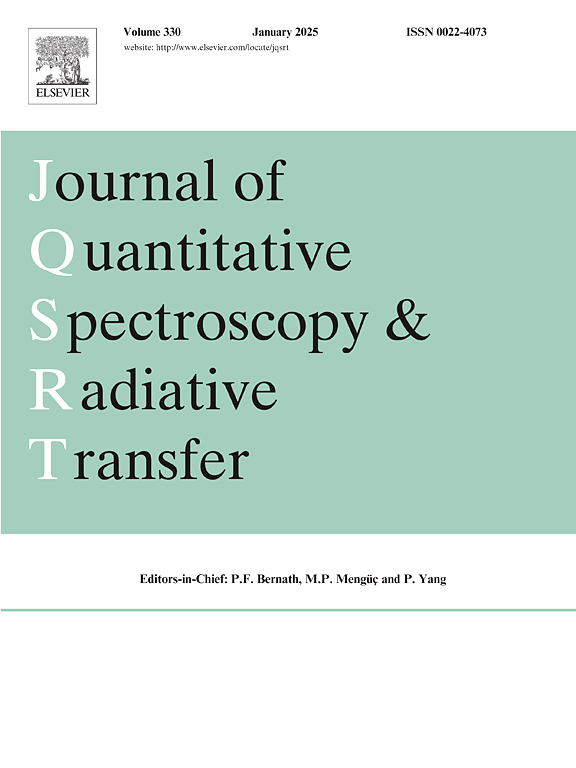Calibration techniques for quantitative NO measurement using Laser-Induced Fluorescence
IF 2.3
3区 物理与天体物理
Q2 OPTICS
Journal of Quantitative Spectroscopy & Radiative Transfer
Pub Date : 2024-10-18
DOI:10.1016/j.jqsrt.2024.109221
引用次数: 0
Abstract
Laser-Induced Fluorescence (LIF) is an essential optical diagnostic technique for the high-resolution and low-uncertainty measurement of combustion species concentration in a variety of applications and conditions. Two different calibration techniques are explored in this study to obtain quantitative Nitric Oxide (NO) concentration measurements in flames. The first technique, the most employed in the literature, uses the extrapolation of the fluorescence signal from seeded to nascent NO and is only valid under negligible NO reburn conditions. The second technique uses the optical calibration of the experimental setup to relate it to a modelled LIF signal and can be applied regardless of NO reburn. Both of these techniques are explored under two different assumptions: constant and non-constant interfering LIF signal on the NO absorption spectrum. While the former is most often used in the literature, the latter is necessary when the LIF signal from interfering species cannot be distinguished from the NO-LIF signal, especially in high pressure conditions. Hence, a total of four techniques are presented in this work and are found to be in excellent agreement when performed in different flame conditions. The calibration techniques are applied to three lean, atmospheric, laminar, premixed, methane-air flames to explore their field of applicability. Specifically, the study explores the relevance of the techniques in reburn conditions, which occur mostly in high pressure, rich, highly-seeded, or NH-containing flames. This study aims to offer the reader a portfolio of calibration techniques to use according to the conditions in which they need to be applied. While this study was carried out measuring NO concentration in a stagnation flame burner, the concepts and equations presented can be transposed to the measurement of other species and to other experimental configurations.
利用激光诱导荧光定量测量 NO 的校准技术
激光诱导荧光(LIF)是一种重要的光学诊断技术,可在各种应用和条件下对燃烧物浓度进行高分辨率和低不确定性测量。本研究探讨了两种不同的校准技术,以获得火焰中一氧化氮(NO)浓度的定量测量值。第一种技术是文献中使用最多的技术,它使用从种子氮氧化物到新生氮氧化物的荧光信号外推法,仅在氮氧化物回烧可忽略不计的条件下有效。第二种技术是利用实验装置的光学校准将其与模拟的 LIF 信号联系起来,无论 NO 是否回烧都可应用。这两种技术都是在两种不同的假设条件下探讨的:氮氧化物吸收光谱上的 LIF 信号恒定和非恒定干扰。前者在文献中最常用,而后者在干扰物种的 LIF 信号无法从 NO-LIF 信号中区分出来时是必要的,尤其是在高压条件下。因此,本研究总共介绍了四种技术,并发现在不同火焰条件下使用这四种技术时,结果非常一致。这些校准技术被应用于三种贫气、大气、层流、预混合的甲烷-空气火焰,以探索其适用范围。具体来说,研究探讨了这些技术在回燃条件下的相关性,回燃主要发生在高压、富裕、高种子或含 NH3 的火焰中。本研究旨在为读者提供一套校准技术组合,以便根据需要应用的条件加以使用。虽然本研究是在停滞火焰燃烧器中测量氮氧化物的浓度,但所介绍的概念和方程可用于测量其他物种和其他实验配置。
本文章由计算机程序翻译,如有差异,请以英文原文为准。
求助全文
约1分钟内获得全文
求助全文
来源期刊
CiteScore
5.30
自引率
21.70%
发文量
273
审稿时长
58 days
期刊介绍:
Papers with the following subject areas are suitable for publication in the Journal of Quantitative Spectroscopy and Radiative Transfer:
- Theoretical and experimental aspects of the spectra of atoms, molecules, ions, and plasmas.
- Spectral lineshape studies including models and computational algorithms.
- Atmospheric spectroscopy.
- Theoretical and experimental aspects of light scattering.
- Application of light scattering in particle characterization and remote sensing.
- Application of light scattering in biological sciences and medicine.
- Radiative transfer in absorbing, emitting, and scattering media.
- Radiative transfer in stochastic media.

 求助内容:
求助内容: 应助结果提醒方式:
应助结果提醒方式:


